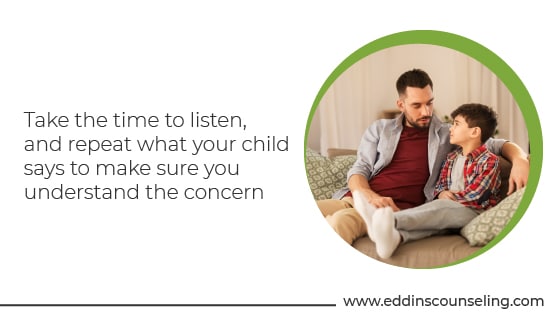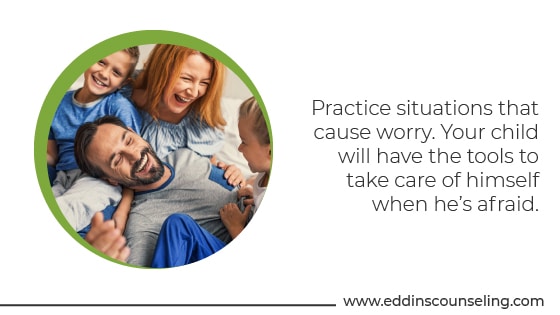November 1, 2021
How to Help a Child with Anxiety
Written by Sara Lane
Posted in Anxiety, Child Counseling and with tags: Anxiety, anxiety in teens, children
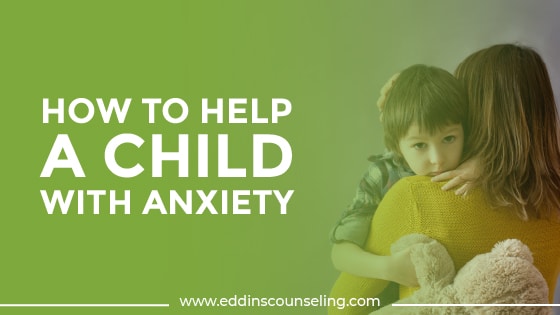
About one in five children in the U.S. suffers from an anxiety disorder.
As parents, the search for solutions on how to help a child with anxiety results from months, even years, of not understanding what is wrong and why your baby is so distressed. It makes you as a parent anxious, which in turn reinforces those feelings.
To prevent that, you are always bottling up our fear to protect them, and it’s just a whole thing. And while anxiety is the top mental health problem children and teens face, fortunately, it is also the most treatable.
Anxiety in children is not usually grown out of: unless they get help from parents and professionals to learn the coping skills they need, they will “grow into” their fears instead.
One nervous child suffers meltdowns when a parent leaves, even temporarily, and another is so terrified of dogs that they can’t play in the park.
Another shy child might be physically sick with headaches, stomach aches, etc. because they fear being humiliated or teased at school.
Whether they are more sensitive to possible danger than usual or learned to be anxious from the people around them, nervous children need help dealing with their anxiety. Knowing how to reassure your shy child in this haywire world can provide that help.
So what to do to help your child live their best life?
In this article, we are going to cover:
- Do you have a child with anxiety or shyness?
- How NOT to reassure your child with anxiety
- How to help them
- 13+ Ways
- Create a Bedtime Routine
- Child Anxiety Treatment
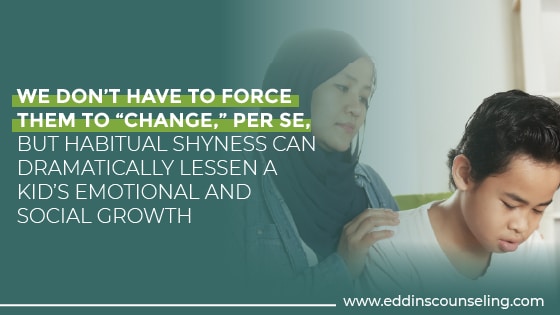
Do You Have a Child with Anxiety or Shyness?
Children don’t have to be socially anxious to be considered shy, and there are endless factors that can contribute to a child’s interaction comfort zone. We don’t have to force them to “change,” per se, but habitual shyness can dramatically lessen a kid’s emotional and social growth.
Striking a balance when addressing a shy child’s need is essential. The short answer is yes.
For example, some children display shy tendencies while remaining secure in their outlook and behavior. A little further along on the spectrum, some kids are shy but wish they could be more outgoing and involved.
At the other end of the spectrum, you’d find children with any number of specific anxiety disorders.
|
|
Some questions to consider when contemplating your child’s reactions and anxiety:
- Is this situation causing your kid to miss out on activities that others their age enjoy?
- How does shyness impact your child’s academic work and social life?
- Are you worrying a lot about your’s child’s shyness?
- Is this leading you to feel differently about your child?
- Do you find yourself altering your actions to work around your kid’s shyness?
Daniel J. Siegel, M.D., is a clinical professor of psychiatry at the UCLA School of Medicine. He believes most children — up to 80 percent — fall into a broad “middle” in terms of introversion or extroversion.
Dr. Siegel recommends parents identify if their child falls into either 10 percent extreme. In the case of excessive shyness, Siegel’s work offers insights into how parents can address social anxiety in their children.
How Not to Reassure
The nervous child turns minor worries into giant fears, out of proportion to the situation. Dismissing the fear with “There’s nothing to be afraid of” doesn’t comfort them.
Trapped in a process they can’t control, these kids can’t see reality. They have a picture in their head that frightens and disturbs them. Facts and logic don’t help them to deal with these feelings.
Just avoiding the cause of the worry doesn’t help, either. Letting a child play alone in his room because he fears the big dog he met in the park last week won’t help him overcome his fear.
The best kind of reassurance helps your anxious child learn to examine and dismiss their fear for themselves. To do that, it’s essential to look closely at the reason for your child’s anxiety.
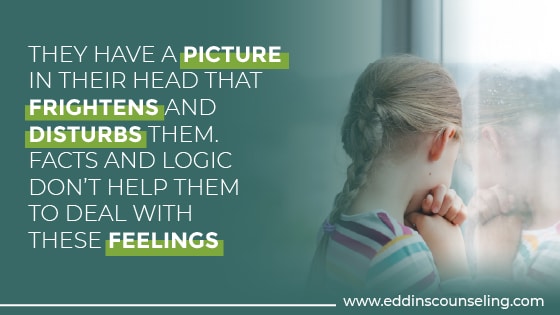
How to Help a Child with Anxiety, Ways
1. Avoidance is Not the Answer
You can’t promise your child an anxiety-free life. Anxiety is a natural part of life that sometimes helps us make good decisions, like avoiding danger or pushing us to work harder.
But when it gets too strong, anxiety inhibits us from living our lives.
So, if you remove everything that makes your child unhappy, you’ll only make your child feel better in the short term. Instead, you should help your child learn to function through the anxiety, and we’ll talk more about that below.
2. Help Your Child with Anxiety Separate Feelings and Facts
First, make sure your nervous child knows that you are there for him. Then help the child see his feelings are not the same as the facts.
Take the time to listen, and repeat what your child says to make sure you understand the concern.
Your anxious child’s fear of the neighbor’s dog or giving a book report in front of the whole class has less to do with the actual situation than with their unrealistic understanding of the risks involved.
Explain what worry is for—to protect us from danger. Then help separate imagined danger from a real threat.
Teach your nervous child to think accurately about the worry. What are their anxious thoughts? What’s the evidence that the worry will come true? What can they say to challenge the fear?
Read more about how healthy communication with your teen can improve your relationship with your child.
3. Educate Yourself on the Topic
The more parents understand what’s going on, the more they can be helpful. A child’s temperament does not have to be their destiny.
However, at this moment, they may lean towards timidity and shyness. They may fear novelty and see danger where it does not exist.
It can be crucial for your child to try counseling. It can be a game-changer if you also work with the therapist to ensure that there’s a carryover into the home (see below).
4. Validate Your Child with Anxiety
Your child does not want to appear as odd or even sick. They want and need your acceptance.
Take time to learn about their interests. Talk with them and create a safe space for them to express emotions.
Parental validation can enable kids to accept themselves as more than someone doing something “wrong.” Cultivate patience in yourself if you wish your child to adopt the same quality.

5. No fear reinforcement
Children are highly perceptive and pick up on behaviors modeled for them unconsciously. If you act stressed out around them or they overhear a phone conversation about not being able to handle something, they will soak this right up.
Still, that’s not to say you should never show anxiety or stress around your children. In general, it’s very healthy for them to see an example of someone they trust functioning under stress as a model for dealing with it themselves.
Encourage your child to be open about his emotions, but never ask yes-or-no questions like “are you worried about X?” Instead, try “how do you feel about X?”
Sometimes children have trouble finding words to describe their emotions, and you might try drawing your feelings together to help them communicate with you!
6. Don’t Over-Protect
Parental instincts can send you into defensive mode. It’s crucial, of course, that your child knows they can rely on you.
Conversely, sheltering a kid will not lead to a place of healing and growth. Over time, it can amplify social anxiety.
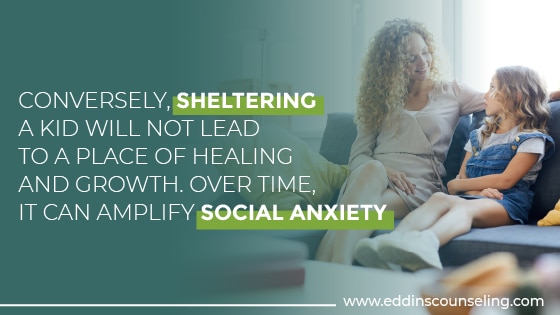
7. Reject Full Immersion, Too
Just because you don’t shelter your child does not mean you instead toss them into the proverbial deep end of the pool. Your kid needs to trust you.
Shocking them with full exposure can be traumatic, and it may also shatter any chance you have to be an ally.
8. Help your child problem-solve
Is there something your child could do to prepare better? About that book report. Would rehearsing help? Practice situations that cause worry. Your child will have the tools to take care of himself when he’s afraid.
Some ways to do this include:
- Personalize fear. Give it a name. Make child’s worry into a character, such as “Mr. Worry Wort” or “Scary Sam.” Role-play scenes so your child can learn to combat these fears.
- Help your nervous child write out a list of worries with clever comebacks.
- Set a time of day and a time limit for worrying. When time is up, close the “worry box” and get on with the day.
- Reward your nervous child when they meet their fears head-on.
Read more: Young Children and Parenting Stress and Anxious Teens: Take These Steps To Help Them Cope.
9. Be both optimistic and realistic
You can’t make promises that you can keep. Sometimes the thing causing your child anxiety will happen. Someone will laugh at her during gym class, or he’ll fall ice skating at a friend’s birthday party.
Maybe that test will be challenging, and she won’t do very well on it. What you can do is tell your child that they will be okay and be supportive.
If you face your fears, they will become less frightening. You don’t want to give your child the impression they are going into something they can’t handle.
You just want to communicate that, no matter what happens, it’s not the end of the world, and you can get through it! Once they see that, yes, she has gotten through it, she will be less anxious about the next potentially unpleasant thing.
Anxiety levels will become manageable and decrease over time.
10. Think It Out
Help your child create a “thought and action plan.” If your child has separation anxiety and is worried about not being picked up after school, help him think out what might happen and how he could act.
This eliminates much of the fear of the unknown and helps children feel empowered to make good decisions! Routines help children feel secure, so having a plan will reduce anxiety.
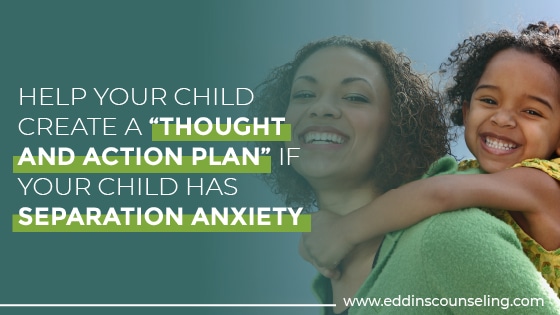
11. Learn the Four S’s
Children want and need to be:
- seen,
- safe,
- soothed, and
- secure.
The four S’s are crucial for any child to cultivate a strong sense of self and move past child anxiety.
12. Breathing Techniques
Sometimes, nothing soothes like a deep breath. When enveloped in feelings of anxiety or fear, redirecting their attention to their breathing can be extremely helpful.
And because you can’t always be with them in moments of stress, teach your child to use deep breathing to calm themselves when they are anxious.
13. Break the Scary Task Up
Break a fearsome task into small, manageable chunks. Today we’ll walk past the neighbor’s dog together, and tomorrow we’ll stop and say hello. Next week, we’ll ask the neighbor if we can pet his dog.
Bonus: Create a Bedtime Ritual
Your child’s sleep habits are either a nightmare or no big deal; there’s rarely any in-between. If your child isn’t sleeping well on a regular basis, it will significantly disrupt both their lives and yours.
Numerous studies show that good sleeping habits benefit children in many ways, from lower levels of obesity and anxiety to improved behavior and school performance.
But good sleep habits don’t just happen by magic.
It’s something that requires some intention on your part. Fortunately, it’s never too late to start developing a bedtime routine for your child with anxiety.
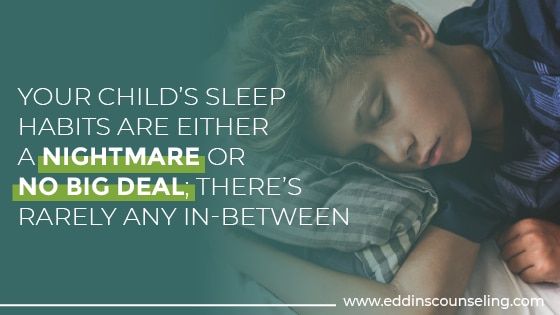
How to Develop a Bedtime Routine
The whole family needs to have good sleep habits—yes, even you. It’s important to stick to regular bedtimes and wake-up times, regardless of the family member.
You’ll know it’s working because your child will fall asleep within 15 minutes and wake up quickly, too.
Many of us look forward to weekends as a chance to catch up on sleep after robbing ourselves of enough rest during the week. But you need to stick to the sleep routine every day.
That means you still stick to the same bedtime on weekends, holidays, and even on vacation. The bright side: such a consistent schedule means there won’t ever be a need to catch up on sleep.

Respect the Schedule of Your Child with Anxiety
Maintaining a healthy sleep schedule will take some dedication. It can be tempting to ignore the sleep schedule just one night a week — like if there’s one night a week, your spouse works late.
While occasionally granting permission to stay up late for a special event can be okay, you mustn’t let it become a frequent occurrence.
Make Sleep a Priority and Be Consistent
It may be a drag to leave a party a bit early to get your kids to bed on time. But your sacrifice now is more likely to pay off in having kids who know how to sleep well later.
Develop a Specific Bedtime Ritual
One of the most critical parts of a bedtime routine is the ritual that goes along with it. Doing the same things every night, in the same order, creates a clear signal that it’s time to wind down and move toward bedtime.
After doing them consistently over time, these predictable actions become expected, and their brain will begin to wind down for the night.
Many common parts of a bedtime routine include taking a bath or washing their face, brushing teeth, having a small snack, and reading a bedtime story.
Promote the Right Behaviors
Certain habits promote or inhibit good sleep. Just as we know that having caffeine too late in the day can wreak havoc on our sleep, it can do the same to our kids.
Today’s kids consume more caffeine than previous generations, and pediatricians recommend that kids avoid caffeine until age 18. However, if your child does have caffeine, at least reduce their daily intake and make sure consumption is only early in the day.
Limit your child’s exposure to TV and electronics, especially at night, both of which can interfere with sleep.
Make sure your child gets regular physical activity, also early in the day. Kids still need the same things they always did: lots of playtime, preferably outdoors in the fresh air. Burning off excess physical energy has a long list of benefits, including leading to better sleep.
Learn more strategies to help kids with autism and insomnia.
Child Anxiety Treatment
Your child has a long road ahead of them, and as parents, we want to make that road as easy and joyful as possible, but that isn’t productive in the long run. Rather than living with this fear and frustration, we recommend you seek help.
Start with a wellness exam to ensure that no physical conditions are tampering with their quality of life, and if the pediatrician says they check out, consult a therapist.
Sleep issues and anxiety can make life extremely challenging for your child, and no parent wants that. You might think that this was caused by something you did, but that guilt won’t help your child get past this.
Helping a child with anxiety begins with understanding the cause of your child’s fears and simply letting them know you support them in whatever way suits them.
Sometimes, we need help collecting the best tools for our kids; and that is where therapy comes in.
At Eddins Counseling Group, we have specialized and experienced child therapists who can help your baby feel like themselves again. For more information, contact us and schedule an appointment at 832-559-2622 or schedule an appointment online.

5 Ways to Reduce Anxiety
Get instant access to your free ebook.
Grounding & Self Soothing
Get instant access to your free ebook.
Create Healthier Thoughts & Feelings
Get instant access to your free ebook.
Why You Feel This Way
Get instant access to your free ebook.

